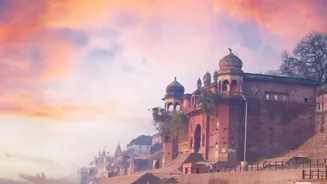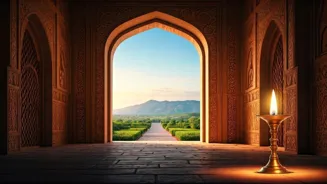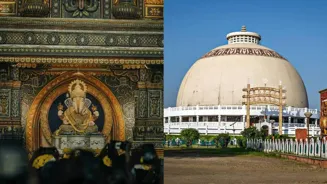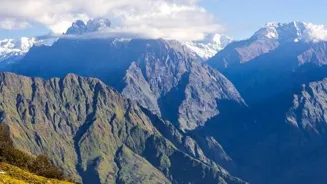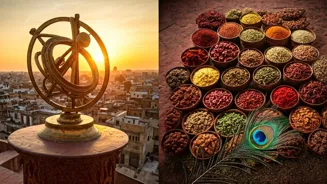Explore the mystical rituals of Varanasi's ghats - a journey of spirituality and tradition. Dive into the soul of India
Varanasi, also known as Kashi or Banaras, is a city that throbs with life, spirituality,
and ancient traditions. Situated on the banks of the holy Ganges, the ghats of Varanasi are not just steps leading to the water; they are stages where life and death play out in a mesmerizing dance.
From sunrise to sunset, and even in the dead of night, these ghats are alive with rituals that are unique to this sacred city. For those seeking a glimpse into the soul of India, Varanasi offers an unparalleled experience. Here are six unique rituals you'll find in this spiritual hub.
Devotees gather at Dashashwamedh Ghat for mesmerizing Ganga Aarti ritual
The Ganga Aarti at Dashashwamedh Ghat is an spectacle of devotion. Every evening, as the sun dips below the horizon, a group of priests performs a synchronized ritual with lamps, incense, and chants. The air fills with the aroma of sandalwood and the rhythmic sounds of bells and conches.
Devotees gather from all corners of the world to witness this mesmerizing display of faith. The towering flames of the lamps reflect in the waters of the Ganges, creating a breathtaking scene.
The priests, adorned in traditional attire, move with precision and grace, their faces reflecting a deep sense of devotion. This ritual is a prayer to the river goddess Ganga, seeking her blessings and thanking her for her life-giving waters.
Participating in or simply observing the Ganga Aarti is an experience that touches the soul and leaves a lasting impression of Varanasi's spiritual energy. It can be said that every day, people are at peace. They pray that this peace will always be there.
Pilgrims in Varanasi shave heads to symbolize new beginnings
Another striking ritual is the practice of shaving heads. Many pilgrims come to Varanasi to get their heads shaved as an offering to their ancestors or as a symbol of renunciation. This act is believed to cleanse the individual of past sins and prepare them for a new spiritual journey.
The ghats are filled with barbers who skillfully perform this ritual, often accompanied by prayers and mantras. For many, it is a deeply emotional experience, a shedding of the old self to embrace a new beginning.
The shaved hair is then offered to the Ganges, symbolizing the relinquishment of worldly attachments. Witnessing this act of devotion is a powerful reminder of the cycle of life, death, and rebirth that is central to Hindu philosophy. It feels like people are letting go of their past.
They believe in the idea of getting to a new chapter.
Cremation rituals in Varanasi for liberation and farewell
The burning ghats of Varanasi, Manikarnika, and Harishchandra, are perhaps the most confronting yet fascinating aspect of the city. Here, funeral pyres burn day and night, as bodies are cremated in the open.
Hindus believe that being cremated in Varanasi liberates the soul from the cycle of reincarnation. The Dom community, who are the traditional caretakers of the cremation grounds, maintain the sacred fires. Although it might seem macabre, the atmosphere is surprisingly serene.
Family members gather to bid farewell to their loved ones, chanting prayers and performing rituals. The sight of the flames and the smoke rising towards the sky serves as a stark reminder of the impermanence of life. While somber, it's a ritual deeply ingrained in their beliefs.
Those who are gone have achieved freedom, and that is important.
Ritual of immersing ashes in Ganges for soul's liberation
The ritual of immersing ashes in the Ganges is another crucial aspect of the cremation process. After the cremation, the ashes of the deceased are collected and immersed in the holy river. This act is believed to help the soul attain moksha, or liberation.
Family members, often accompanied by priests, perform this ritual with great reverence. They chant mantras and offer prayers as they release the ashes into the flowing waters. The Ganges, considered a sacred purifier is believed to carry the soul to the divine realm.
The river is seen as a pathway to the spiritual world. Seeing the ashes immersed reminds everyone, even the observers, of the end.
Feeding Sadhus along ghats is a revered Hindu tradition
The tradition of feeding the Sadhus is a common sight along the ghats. Sadhus, or wandering ascetics, are revered in Hindu society for their renunciation of worldly possessions and their dedication to spiritual pursuits. Many pilgrims and locals offer food and alms to the Sadhus as an act of piety.
This practice is believed to bring good karma and blessings. The Sadhus, often clad in saffron robes, accept the offerings with gratitude and offer their blessings in return.
They are seen as living representations of the divine, and feeding them is considered a way to connect with the spiritual realm. They often wander on their own, having made the decision to leave everything behind.
Studying Vedas and Upanishads by Varanasi's ghats upholds intellectual heritage
Finally, the practice of learning the Vedas and Upanishads along the ghats is a testament to Varanasi's rich intellectual heritage. Many traditional schools and gurus have set up along the riverbanks, imparting knowledge of ancient scriptures to their disciples.
The air is filled with the sound of chanting and recitations, creating a unique atmosphere of learning and devotion. Students spend years studying the Vedas, Upanishads, and other sacred texts, preserving and passing on the wisdom of their ancestors.
By immersing themselves in Vedic studies, they are connecting with the deepest truths of existence and seeking enlightenment. The students and teachers dedicate their lives to learning.
AI Generated Content. Glance/InMobi shall have no liability for the content
